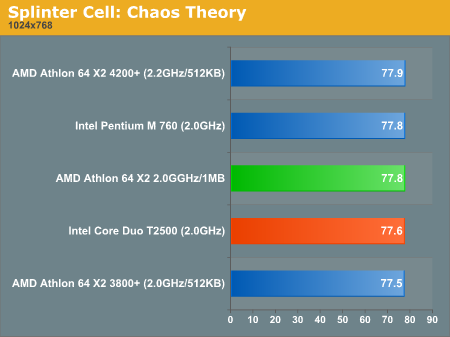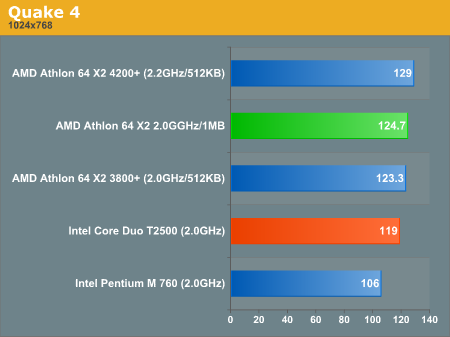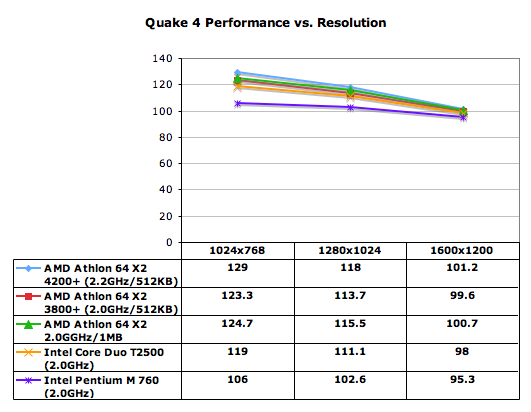Intel Core Duo (Yonah) Performance Preview - Part II
by Anand Lal Shimpi on December 19, 2005 12:55 PM EST- Posted in
- CPUs
Gaming Performance with Splinter Cell: CT and Quake 4
While Splinter Cell doesn't show any performance differences between the offerings, we do see a bit of a breakdown with Quake 4. Here, the Core Duo T2500 presents a 12% increase in performance (note that this is without the recent dual-core Quake 4 patch) over the Pentium M 760, but still trails behind the Athlon 64 X2.
While Splinter Cell doesn't show any performance differences between the offerings, we do see a bit of a breakdown with Quake 4. Here, the Core Duo T2500 presents a 12% increase in performance (note that this is without the recent dual-core Quake 4 patch) over the Pentium M 760, but still trails behind the Athlon 64 X2.













103 Comments
View All Comments
Hacp - Monday, December 19, 2005 - link
If you want performance of an AMD X2 in a notebook package, the Yonah duo is the way to go.Griswold - Monday, December 19, 2005 - link
Or you wait for dual core Turion. Same thing.Accord99 - Monday, December 19, 2005 - link
But at 2-3x the power consumption.Houdani - Monday, December 19, 2005 - link
http://www.anandtech.com/cpuchipsets/showdoc.aspx?...">http://www.anandtech.com/cpuchipsets/showdoc.aspx?...No need to exaggerate unnecessarily.
Accord99 - Monday, December 19, 2005 - link
That's a system power consumption, I was referring to CPU only. And in a laptop environment, the power usage of the other components are much smaller so the impact of the CPU portion is greater. 90nm single Turions are already uncompetitive with Yonah, making them dual core will just make it worse.saratoga - Monday, December 19, 2005 - link
The difference will most likely be less then 2x judging by the relative power consumption of Dothan and Venice @ 90nm, so you're still wrong.Also, Yonah is a 65nm chip. It should not be surprising that it has an edge over 90nm chips.
Accord99 - Monday, December 19, 2005 - link
Dothan vs Turion ML has a 2X or greater edge under load. Yonah has comparable power consumption to Dothan while 90nm dual core Turions will clearly go up. 3X is not out of the question for non-undervolted DC Turions.Shintai - Monday, December 19, 2005 - link
Ye I would guess on something like 35W will be 40-45W with 65nm Turion X2, unless you sacrifice speeds. The 25W part might be 35-40W.But Turion really never had a chance, since it´s not designed for low power. And as we already saw in the benchies. Who want a dualcore Turion running at 1.8Ghz or less against a 2.13Ghz Yonah when the yonah uses less power.
Intel briliant move so Dothan->Yonah only gave 9% more transistors. Turion->Turion X2 will add 110-120% more transistors (Over 100% due to crossbar between CPUs).
So Yonah will also be cheaper to make than a dualcore Turion.
Furen - Thursday, December 22, 2005 - link
Intel did slice the "cache per core" in half with Yonah, so AMD could conceivably make Dual-core Turions have 512k per core, which would make the die-size increase around 50%, though this will probably have a greater impact on performance on the AMD side, since Dothan's cache was insanely huge to begin with.About the price: AMD Turions will always be cheaper than their direct analogs from Intel because AMD needs to perform the same AND have a better price for people to use it, otherwise they'll go with the market leader, so I dont think we'll ever be faced with chosing between a 1.8GHz Turion and a 2.13GHz Yonah. This is regardless of the production cost, though AMD's margins may take a big hit if Intel pushes prices hard enough.
bob661 - Monday, December 19, 2005 - link
pnw3d